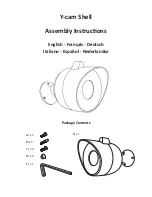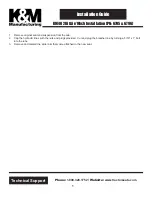
1
of 5
© 2014 TE Connectivity family of companies
All Rights Reserved
*Trademark
TE Connectivity, TE connectivity (logo), and TE (logo) are trademarks. Other logos, product, and/or company names may be trademarks of their respective owners.
TOOLING ASSISTANCE CENTER 1-800-722-1111
PRODUCT INFORMATION 1-800-522-6752
This controlled document is subject to change.
For latest revision and Regional Customer Service,
visit our website at www.te.com.
Instruction Sheet
408-32154
18 NOV 14
Rev A
Not available from TE Connectivity—1.5-mm are manufactured by Molex; 2.8- and 6.3-mm are manufactured by Delphi.
Figure 1
Plug assembly features are given in Figure 1. Contacts and a wire dress cover, both available separately, are
required for assembly. Contact description and wire dress cover part numbers and features are given in Figure 1.
1.
ASSEMBLY
1.1.
Insert Contacts
1. Ensure that the TPA and rotating locking lever are each in the open (unlocked) position. Refer to
Figure 1. If either are not in the open (unlocked) position, refer to Paragraphs 2.1 (TPA) and 2.3
(rotating locking lever).
2. Crimp the contacts according to instructions provided by the manufacturer.
3. Select the plug housing contact cavities to be loaded with contacts. Refer to the table in Figure 1.
4. From the wire end of the plug, align each crimped contact with the applicable contact cavity as
described in Figure 2, Detail A. Grasp the wire of the contact and insert the contact straight into the
contact cavity. See Figure 2, Detail B. The retention latch finger of the contact cavity will be deflected
by the contact and hold it in place.
5. Lightly pull each wire to ensure that the retention latch finger is holding the contact in place.
Automotive Unsealed Hybrid
Plug Assemblies 2098627-[ ] (22 Positions)
and 2138731-[ ] (36 Positions)
Terminal Position Assurance
(TPA) in Open (Unlocked)
Position (Protrudes Slightly
from Bottom of Housing)
Hybrid Plug Assembly
(22-Position Shown)
90-Degree Wire Dress Cover
(22-Position Shown)
PLUG
ASSEMBLY
POSITIONS
CONTACTS
WIRE DRESS
COVER
Type
Amount (Contact Cavity)
2098627-[ ]
22
1.5-mm
12 (Small)
2098628-1
2.8-mm
0
7 (Medium)
6.3-mm
0
3 (Large)
2138731-[ ]
36
1.5-mm
20 (Small)
2098622-1
2.8-mm
10 (Medium)
6.3-mm
0
6 (Large)
Rotating Locking Lever
in Open (Unlocked)
(Horizontal) Position
Housing
Contact Cavities
Mating Face
Lever Locking
Latch
Retention Tab
(2 Places)
Wire Exit
Locking
Beam
Molex and Delphi are trademarks of their respective owners.























